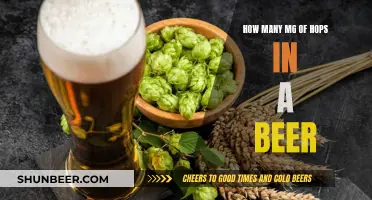
Hops are a flower of the plant Humulus lupulus, a member of the Cannabaceae family. They are one of the four essential ingredients in beer, alongside barley, yeast, and water. Hops are added to the boil stage of brewing, taking around an hour to release the alpha acids that give beer its bitter taste and balance the sweetness of the malt. They also add flavour and act as a preservative, helping to keep beer fresh for longer. Hops are divided into three categories: bittering hops, which have high levels of alpha acids; finishing hops, which have high aroma levels; and dual-purpose hops, which are a combination of both.
| Characteristics | Values |
|---|---|
| Scientific name | Humulus lupulus |
| Plant type | Climbing |
| Flower shape | Cone-shaped |
| Family | Cannabaceae |
| Cousins | Cannabis, hemp, marijuana |
| Functions | Flavouring, bittering, stability agent, antibacterial |
| Preservation | Acts as a preservative |
| Alpha acids | Create bitterness |
| Beta acids | Create aroma |
| Essential oils | Create aroma |
| Aromas | Citrus, pine, mango, resin, melon, floral, fruity, earthy, spicy, grapefruit |
| Preservation | Helps beer stay fresh for longer |
| Foam | Helps beer retain its head of foam |
What You'll Learn

Hops add flavour and aroma to beer
Hops are the flowers (also called seed cones or strobiles) of the hop plant Humulus lupulus, a member of the Cannabaceae family of flowering plants. They are used to add flavour and aroma to beer, as well as bitterness and stability.
The unique flavours and aromas of hops come from the resins and oils inside the lupulin glands of the hop cones. The hop cones contain different oils, such as lupulin, a yellowish, waxy substance that imparts flavour and aroma to beer. Lupulin contains substances with antibiotic properties, which help to preserve the beer and prevent spoilage.
The flavour and aroma of hops can be altered by when they are added during the brewing process. Hops added early in the brewing process will have more time to release their "alpha" acids, which create a bitter taste. However, the longer boiling time will also cause the aromatic oils to evaporate. Therefore, if a stronger hoppy aroma is desired, the hops should be added later in the process. Techniques such as dry hopping, where hops are fermented with the beer, and wet hopping, where fresh, un-dried hops are used within 24 hours of being harvested, can also be used to add aroma without extra bitterness.
The flavour and aroma of hops can vary depending on the region where they are grown, similar to how the characteristics of grapes can vary based on their region. Hops grown in different regions will have different flavour and aroma profiles, which will impact the final beer.
Mastering Beer Smith 3: Displaying Multiple Dry Hops
You may want to see also

Hops are added during the boil stage of brewing
Bittering hops are added early in the boil process to impart bitterness, as they release more alpha acids the longer they are boiled. Aroma hops, on the other hand, are added towards the end of the boil to emphasise their aromatic qualities and reduce the bitterness they impart. The later in the process the hops are added, the more their aromatics are emphasised.
The degree of bitterness imparted by the hops depends on the degree to which alpha acids are isomerized during the boil. The impact of a given amount of hops is specified in International Bittering Units (IBU). The IBU level of a beer indicates the amount of iso-alpha acids in the beer and, thus, its bitterness.
The choice and timing of hops will vary depending on the style of beer being brewed and the desired flavour profile. For example, adding aroma hops early in the brewing process will cause most of the essential oils to boil away, resulting in a less "hoppy" aroma. However, adding aroma hops later in the process will create a stronger hoppy smell.
In addition to their flavour contributions, hops also have a role in the stability of the finished beer. The acids in hops act as a preservative, helping to keep the beer fresher for longer.
Hops' Preservative Powers: Keeping Beer Fresh
You may want to see also

Hops are divided into three categories: bittering, finishing, and dual-purpose
Hops are the flowers, or cones, of the hop plant, *Humulus lupulus*. They are added to beer during the brewing process to impart a bitter taste, add flavour, act as a preservative, and help the beverage retain its head of foam. Hops also add balance, counteracting the sweetness of the malt.
Hops-Centric Beers: High Hop Brews to Try
You may want to see also

Hops are used to balance the sweetness of the malt
Hops are the flowers, or cones, of the hop plant, Humulus lupulus, a member of the Cannabaceae family of flowering plants. They are used in beer production primarily as a bittering, flavouring, and stability agent. Hops are also used for various purposes in other beverages and herbal medicine.
Hops help to balance the sweetness of the malt in beer. Malt adds sweetness and alcohol content to beer, and hops add bitterness. The level of bitterness depends on the alpha acid content of the hops, the amount of hops used, and the length of time the hops are boiled. Hops with higher alpha acid levels are used for bittering, while those with higher aroma levels are used for finishing. Dual-use hops are a combination of both.
Hops provide a range of flavours and aromas to beer, from citrus and pine to earthy and spicy. The hop flowers added to beer contain a large amount of leafy vegetative matter, and the flavours associated with hops tend to be correspondingly plant-like. The particular flavours and aromas of hops can be classified into several categories, including floral, fruity, citrus, herbal, earthy, piney, and spicy.
Hops are essential in beer production as they help to balance the sweetness of the malt, providing a bitter flavour that complements the sweetness of the malt. Without the bitterness from the hops, beer would taste overly sweet. Additionally, hops have antibacterial properties and act as a preservative, helping to extend the shelf life of beer.
By adding hops at different stages of the brewing process, brewers can emphasise certain flavours and aromas. For example, adding hops early in the brewing process will emphasise bitter flavours, while adding hops later will emphasise aromatic qualities. Techniques such as dry hopping and wet hopping can also be used to modify the flavour and aroma profile of the beer.
Budweiser's Hoppy Taste: Beer Style Secrets Revealed
You may want to see also

Hops help preserve beer
Hops, the flowers of the hop plant Humulus lupulus, play a crucial role in preserving beer. They possess antibacterial properties, inhibiting the growth of undesirable microorganisms and reducing the likelihood of spoilage. This preservative effect was a key reason why traditional herb combinations, known as "gruit," were phased out in favour of hops in beer production.
Hops contain alpha acids or humulones, which are released during the boiling process and contribute to the bitter taste of beer. The longer the boiling time, the more alpha acids are extracted from the hops, intensifying the bitterness. This is why hops are typically added early in the brewing process for bittering purposes.
However, hops are also valued for their aromatic qualities. Adding hops later in the brewing process or during fermentation, a technique known as "dry hopping," enhances the "hoppy" aroma without increasing bitterness. The highly volatile essential oils in hops, such as myrcene, humulene, and caryophyllene, are responsible for the distinctive "hoppy" aromas and flavours that beer enthusiasts seek.
The choice and timing of hop additions depend on the desired style and flavour profile of the beer. While some beers showcase the bitterness provided by hops, in other cases, hops play a supporting role, adding subtle nuances to the aroma and flavour while allowing other ingredients to shine.
In addition to their preservative effects, hops also help beer retain its head of foam, a key component of a beer's aroma and flavour profile. The acids in hops act as a natural preservative, prolonging the shelf life of beer and ensuring it stays fresher for longer.
Dry Hopping Beer: Pellet Power for Aromatic Brews
You may want to see also
Frequently asked questions
Hops are the flowers (also called seed cones or strobiles) of the hop plant Humulus lupulus, a member of the Cannabaceae family of flowering plants.
Hops are used primarily as a bittering, flavouring, and stability agent in beer. They balance the sweetness of the malt with bitterness and a variety of flavours and aromas.
Hops are often divided into three categories: bittering hops, aroma hops, and dual-purpose hops. Bittering hops have higher concentrations of alpha acids and are responsible for the bitter flavour of a beer. Aroma hops tend to have more essential oils that contribute to the "hoppiness" of the beer. Dual-purpose hops are used for both aroma and bitterness.
The craft beer brewers are after the lupulin in hops, which contributes to the taste, aroma, and bitterness of the beer. Hops can be added during several points of the brewing process to alter the taste, bitterness, and aroma. For example, adding aroma hops early in the brewing process will cause most of the essential oils to boil away, resulting in a less "hoppy" smell.
Some common varieties of hops used in beer include Citra, Cascade, Mosaic, Amarillo, Simcoe, and Saaz. Citra hops, for example, are often used in American Ales, Amber beers, and IPAs, adding tropical fruit and citrus characters to the beer. Saaz hops, on the other hand, are mostly used in lagers and pilsners and have an aromatic blend, earthy flavours, and low bitterness.







